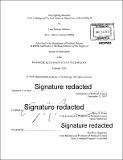| dc.contributor.advisor | Barry R. Posen. | en_US |
| dc.contributor.author | Andrews, Lena Simone | en_US |
| dc.contributor.other | Massachusetts Institute of Technology. Department of Political Science. | en_US |
| dc.date.accessioned | 2018-08-08T19:48:29Z | |
| dc.date.available | 2018-08-08T19:48:29Z | |
| dc.date.copyright | 2018 | en_US |
| dc.date.issued | 2018 | en_US |
| dc.identifier.uri | http://hdl.handle.net/1721.1/117308 | |
| dc.description | Thesis: Ph. D., Massachusetts Institute of Technology, Department of Political Science, 2018. | en_US |
| dc.description | Cataloged from PDF version of thesis. | en_US |
| dc.description | Includes bibliographical references (pages 389-408). | en_US |
| dc.description.abstract | militaries learn in war by developing and testing a theory of wartime military learning in the joint operational context. In doing so, the dissertation makes three related arguments. First, it examines not just whether militaries learn in war, but how militaries learn in war. Specifically, it defines learning as a process that includes two distinct but related phases: first, identifying a problem and, second, implementing a solution. From this conceptual standpoint, the dissertation then proposes a theory of wartime military learning that can explain and predict both whether and how a military is likely to learn the lessons of war, which I call Military Filtration Theory (MFT). MFT argues that wartime military learning is best explained by examining the interaction of two key variables: first, the state's national military strategy and, second, the military's resource endowments. These two variables act as a filter on the information that is identified and absorbed by military organizations throughout the learning process. Finally, the dissertation tests MFT against several alternative explanations in the novel and challenging empirical setting of joint operations. Specifically, I examine the different experiences of the British, American, and German militaries in successfully learning to execute tactical airpower operations during World War II. In addition to demonstrating variation in the learning process, these three cases allow me to focus on a subset of joint operations that sets a high bar for existing theories of military learning in ways that the extant literature does not. The findings of this study provide new theoretical and empirical insights for students of military learning, as well as several practical lessons for policymakers and warfighters. | en_US |
| dc.description.statementofresponsibility | by Lena Simone Andrews. | en_US |
| dc.format.extent | 408 pages | en_US |
| dc.language.iso | eng | en_US |
| dc.publisher | Massachusetts Institute of Technology | en_US |
| dc.rights | MIT theses are protected by copyright. They may be viewed, downloaded, or printed from this source but further reproduction or distribution in any format is prohibited without written permission. | en_US |
| dc.rights.uri | http://dspace.mit.edu/handle/1721.1/7582 | en_US |
| dc.subject | Political Science. | en_US |
| dc.title | One fighting machine : joint learning and tactical airpower operations in World War II | en_US |
| dc.title.alternative | 1 fighting machine : joint learning and tactical airpower operations in World War II | en_US |
| dc.title.alternative | Joint learning and tactical airpower operations in World War II | en_US |
| dc.type | Thesis | en_US |
| dc.description.degree | Ph. D. | en_US |
| dc.contributor.department | Massachusetts Institute of Technology. Department of Political Science | |
| dc.identifier.oclc | 1045069374 | en_US |
